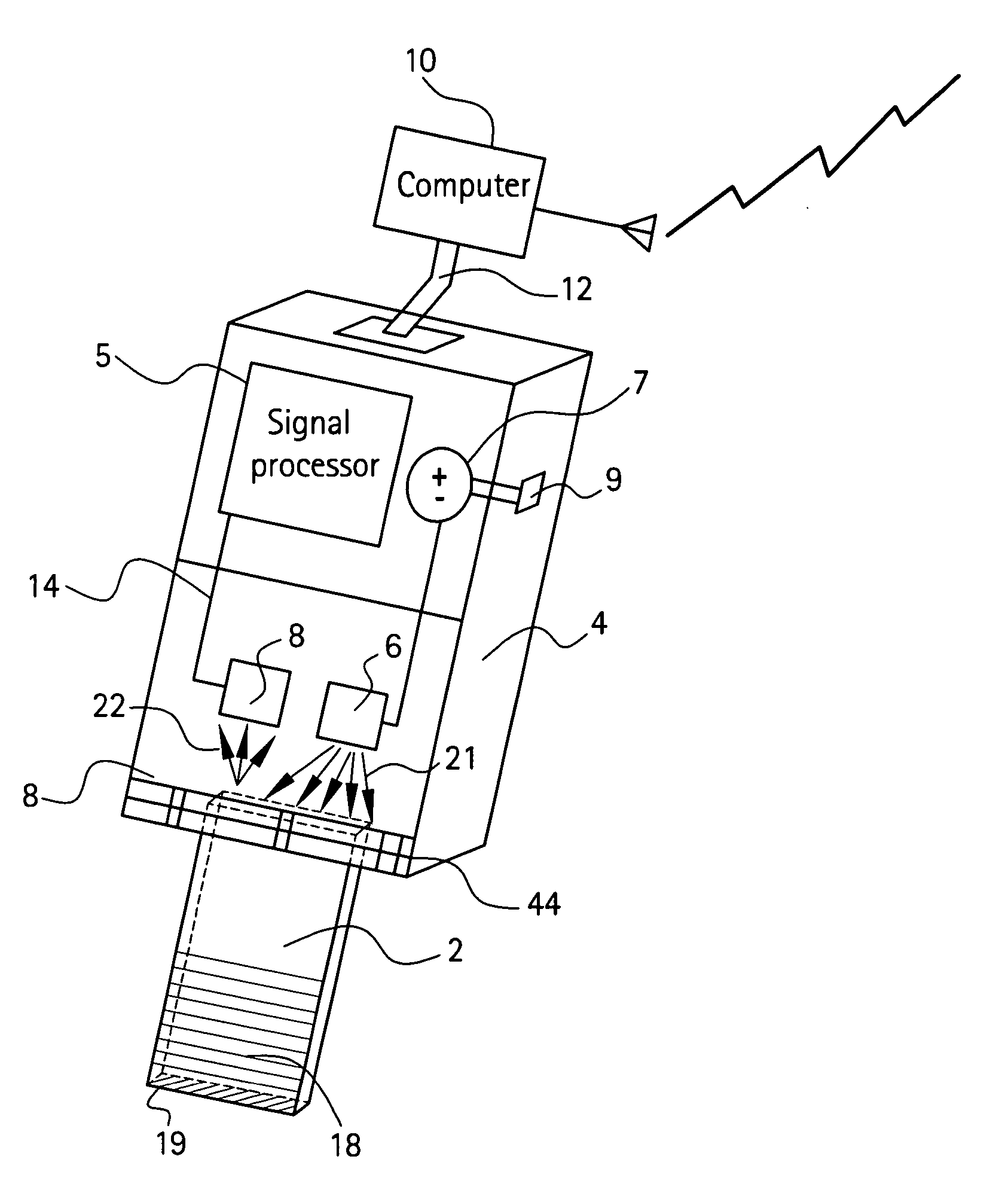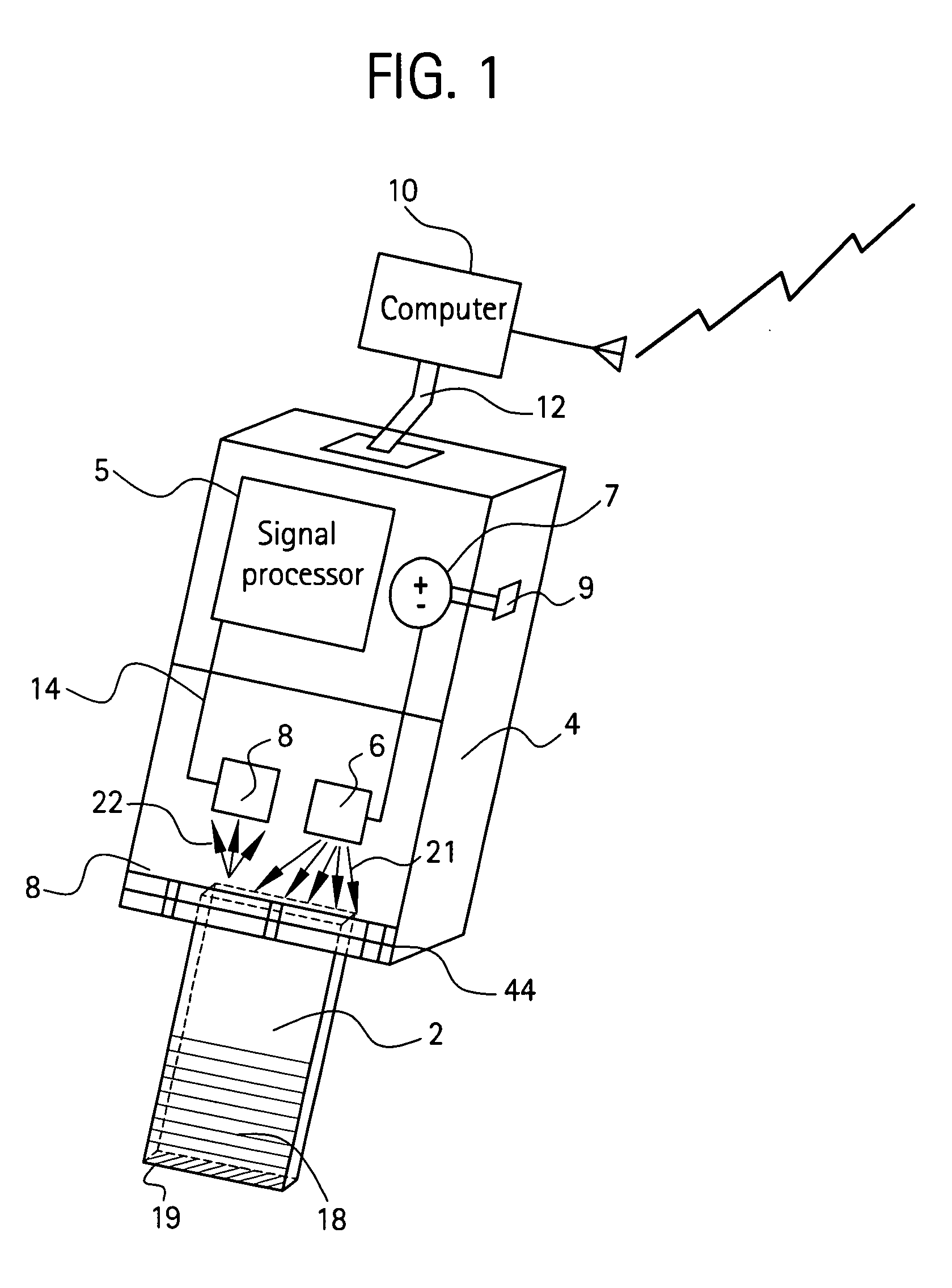Handheld device with a disposable element for chemical analysis of multiple analytes
a technology of disposable elements and handheld devices, applied in chemical methods analysis, color/spectral properties measurement, instruments, etc., can solve the problems of inconvenient sample manipulation and reagent handling, difficult to produce disposable optical sensor elements for calibration free tests, and inability to easily determine more than one unrelated analyte in a single test. , to achieve the effect of high responsiveness and convenient portability
- Summary
- Abstract
- Description
- Claims
- Application Information
AI Technical Summary
Benefits of technology
Problems solved by technology
Method used
Image
Examples
example 1
[0077] Four edges of a Fisher brand, clear glass slide (dimensions 3″×1″×0.41″, Fisher catalog number 12-549) were painted with a white paint pen (Uni®Paint PX-20) as shown in FIG. 14. An area near one end was also painted with the white paint pen. The arrangement of LED and photocell is shown in FIG. 14. The light source was a 5 mm, 3000 mcd red LED, with peak emission wavelength at 660 nm and a viewing angle 12° available from RadioShack®. Absorbance levels of different concentrations of blue lines made with a permanent, fine point Sharpie® marker are shown in FIG. 6. Here, during the initial time interval 0-22 seconds, light was projected onto a blank (no blue marking) glass slide. As expected, the corresponding absorbance level shown at line 50 is approximately zero. After approximately 22 seconds, a single blue line was made on the glass slide, and the corresponding absorbance level increased to line 51 as shown. After approximately 34 seconds, a second blue line was made on to...
example 2
[0079] In this second example, a 3.7″×0.49″×0.21″ polycarbonate reflection element was made. An end of the polycarbonate element was beveled to an angle equal to approximately 51°. The test element configuration for absorbance measurement used in this example is shown in FIG. 7. Here, an Ocean Optics P400-2 six optical fiber bundle was used to provide the incident light from an Ocean Optics tungsten-halogen lamp. An R400-7 Ocean Optics reflection probe was used to collect the reflected light to an Ocean Optics USB2000 spectrometer. Before a poly (2-hydroxylethyl methacrylate) (PHEMA) film containing tetramethylbenzidine (TMB) was dip coated on one side of the polycarbonate element, a blank spectrum with zero absorbance for all wavelengths was established. After the TMB film was coated, the polycarbonate element was put back to the configuration as shown in FIG. 7. Here, a baseline spectrum was first recorded. Next, a 0.06 ml 0.1 ppm sodium hyperchlorite solution was carefully spread...
example 3
[0080] The same Ocean Optics spectrometer system from Example 2 was used in this example. A microscope slide holder tightly controlled the positioning of the glass slide. The incident optical fiber probe was directed to one side of the glass slide at roughly 45° angle with respect to the glass slide plane. About half of the incident light illuminated the white paper underneath the glass slide and the other half illuminated an edge of the glass slide. The detection probe was also angled at about 45° and the distance from the probe to the slide was adjusted so that the amount of light does not saturate the spectrometer.
[0081] A PHEMA film containing a small amount of red dye was recovered from a permanent red Sharpie® marker. A solution of red dye was spin coated on glass slides as in Example 1 with a spinner modified from a magnetic stirrer, which does not have speed control or readout. The spinner acceleration, the final spin speed, and spinning duration were not controlled. The re...
PUM
 Login to View More
Login to View More Abstract
Description
Claims
Application Information
 Login to View More
Login to View More - R&D
- Intellectual Property
- Life Sciences
- Materials
- Tech Scout
- Unparalleled Data Quality
- Higher Quality Content
- 60% Fewer Hallucinations
Browse by: Latest US Patents, China's latest patents, Technical Efficacy Thesaurus, Application Domain, Technology Topic, Popular Technical Reports.
© 2025 PatSnap. All rights reserved.Legal|Privacy policy|Modern Slavery Act Transparency Statement|Sitemap|About US| Contact US: help@patsnap.com



